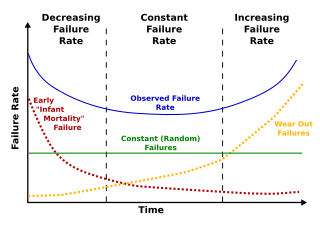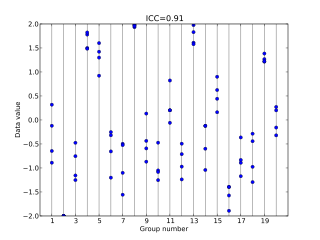Related Research Articles

Psychological statistics is application of formulas, theorems, numbers and laws to psychology. Statistical Methods for psychology include development and application statistical theory and methods for modeling psychological data. These methods include psychometrics, Factor analysis, Experimental Designs, and Multivariate Behavioral Research. The article also discusses journals in the same field.
In reliability engineering, the term availability has the following meanings:

Free-space optical communication (FSO) is an optical communication technology that uses light propagating in free space to wirelessly transmit data for telecommunications or computer networking. "Free space" means air, outer space, vacuum, or something similar. This contrasts with using solids such as optical fiber cable.
In statistics and psychometrics, reliability is the overall consistency of a measure. A measure is said to have a high reliability if it produces similar results under consistent conditions:
"It is the characteristic of a set of test scores that relates to the amount of random error from the measurement process that might be embedded in the scores. Scores that are highly reliable are precise, reproducible, and consistent from one testing occasion to another. That is, if the testing process were repeated with a group of test takers, essentially the same results would be obtained. Various kinds of reliability coefficients, with values ranging between 0.00 and 1.00, are usually used to indicate the amount of error in the scores."
Classical test theory (CTT) is a body of related psychometric theory that predicts outcomes of psychological testing such as the difficulty of items or the ability of test-takers. It is a theory of testing based on the idea that a person's observed or obtained score on a test is the sum of a true score and an error score. Generally speaking, the aim of classical test theory is to understand and improve the reliability of psychological tests.
Repeatability or test–retest reliability is the closeness of the agreement between the results of successive measurements of the same measure, when carried out under the same conditions of measurement. In other words, the measurements are taken by a single person or instrument on the same item, under the same conditions, and in a short period of time. A less-than-perfect test–retest reliability causes test–retest variability. Such variability can be caused by, for example, intra-individual variability and inter-observer variability. A measurement may be said to be repeatable when this variation is smaller than a pre-determined acceptance criterion.

Burn-in is the process by which components of a system are exercised before being placed in service. This testing process will force certain failures to occur under supervised conditions so an understanding of load capacity of the product can be established.
Failure rate is the frequency with which an engineered system or component fails, expressed in failures per unit of time. It is usually denoted by the Greek letter λ (lambda) and is often used in reliability engineering.
Cohen's kappa coefficient (κ) is a statistic that is used to measure inter-rater reliability for qualitative (categorical) items. It is generally thought to be a more robust measure than simple percent agreement calculation, as κ takes into account the possibility of the agreement occurring by chance. There is controversy surrounding Cohen's kappa due to the difficulty in interpreting indices of agreement. Some researchers have suggested that it is conceptually simpler to evaluate disagreement between items.
Reliability engineering is a sub-discipline of systems engineering that emphasizes the ability of equipment to function without failure. Reliability describes the ability of a system or component to function under stated conditions for a specified period of time. Reliability is closely related to availability, which is typically described as the ability of a component or system to function at a specified moment or interval of time.
Α video codec is software or a device that provides encoding and decoding for digital video, and which may or may not include the use of video compression and/or decompression. Most codecs are typically implementations of video coding formats.
Fleiss' kappa is a statistical measure for assessing the reliability of agreement between a fixed number of raters when assigning categorical ratings to a number of items or classifying items. This contrasts with other kappas such as Cohen's kappa, which only work when assessing the agreement between not more than two raters or the intra-rater reliability. The measure calculates the degree of agreement in classification over that which would be expected by chance.
In statistics, inter-rater reliability is the degree of agreement among independent observers who rate, code, or assess the same phenomenon.

In statistics, the intraclass correlation, or the intraclass correlation coefficient (ICC), is a descriptive statistic that can be used when quantitative measurements are made on units that are organized into groups. It describes how strongly units in the same group resemble each other. While it is viewed as a type of correlation, unlike most other correlation measures it operates on data structured as groups, rather than data structured as paired observations.
The Autism Diagnostic Interview-Revised (ADI-R) is a structured interview conducted with the parents of individuals who have been referred for the evaluation of possible autism or autism spectrum disorders. The interview, used by researchers and clinicians for decades, can be used for diagnostic purposes for anyone with a mental age of at least 24 months and measures behavior in the areas of reciprocal social interaction, communication and language, and patterns of behavior.
High Efficiency Video Coding (HEVC), also known as H.265 and MPEG-H Part 2, is a video compression standard designed as part of the MPEG-H project as a successor to the widely used Advanced Video Coding. In comparison to AVC, HEVC offers from 25% to 50% better data compression at the same level of video quality, or substantially improved video quality at the same bit rate. It supports resolutions up to 8192×4320, including 8K UHD, and unlike the primarily 8-bit AVC, HEVC's higher fidelity Main10 profile has been incorporated into nearly all supporting hardware.
SERVIS-1, or Space Environment Reliability Verification Integrated System 1, is a Japanese satellite designed for testing the performance of commercial off-the-shelf products in the space environment. It has a mass of about 840 kg, and was launched on 30 October 2003 from the Plesetsk Cosmodrome by Eurockot, who used a Rokot rocket with a Briz-KM upper stage. The satellite was active for two years. A second satellite, SERVIS-2, was launched in 2010.
The Berg Balance Scale is a widely used clinical test of a person's static and dynamic balance abilities, named after Katherine Berg, one of the developers. For functional balance tests, the BBS is generally considered to be the gold standard.
Bacterial phylodynamics is the study of immunology, epidemiology, and phylogenetics of bacterial pathogens to better understand the evolutionary role of these pathogens. Phylodynamic analysis includes analyzing genetic diversity, natural selection, and population dynamics of infectious disease pathogen phylogenies during pandemics and studying intra-host evolution of viruses. Phylodynamics combines the study of phylogenetic analysis, ecological, and evolutionary processes to better understand of the mechanisms that drive spatiotemportal incidence and phylogenetic patterns of bacterial pathogens. Bacterial phylodynamics uses genome-wide single-nucleotide polymorphisms (SNP) in order to better understand the evolutionary mechanism of bacterial pathogens. Many phylodynamic studies have been performed on viruses, specifically RNA viruses which have high mutation rates. The field of bacterial phylodynamics has increased substantially due to the advancement of next-generation sequencing and the amount of data available.
References
- ↑ "Stroke Engine glossary (McGill Faculty of Medicine)". Archived from the original on 2010-03-09. Retrieved 2010-03-10.
- ↑ "Outcomes database glossary". Archived from the original on 2010-04-23. Retrieved 2010-03-10.